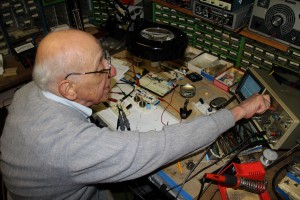
Ralph H. Baer poses in Norman Rockwell Museum's Archives in September 2011, with a painting of another pioneer: Daniel Boone. Mr. Baer is considered the "father of video games," and donated the original Norman Rockwell painting to the Museum back in the 1990s. Photo courtesy Ralph H. Baer. All rights reserved.
Norman Rockwell Museum recently had the special honor of a visit from a man who is not only one of our generous art donors, but also a true innovator (in a field that is now a billion dollar industry)! Ralph H. Baer is considered “the father of video games.” Back in the late 1960s, this creative engineer developed the first of a series of games to play on a television screen, including the popular ping-pong game. A few years later he teamed up with Magnavox to release Odyssey, the first home video game console, based on his original “Brown Box” prototype. The console included an assortment of unique controls, including a light-activated toy gun, which is still being used in video game technology to this day.
Baer continued to experiment with technology in the 1970s, creating the immensely popular music game SIMON. He also produced some of the first musical greeting cards and toys, which now have become so commonplace in this electronic age. At age 89, this pioneer is as active as ever, serving as a consultant for engineering and the video game industry, and still hard at work on new ideas. He recently welcomed representatives from Norman Rockwell Museum to his home in Manchester, New Hampshire, where he agreed to a videotaped interview about his remarkable career (this interview is now part of the Museum’s ever-expanding archive of oral histories).

At age 89, Ralph H. Baer is as ever busy as ever. Here, he tinkers away in his Manchester, New Hampshire laboratory/home. Photo by Norman Rockwell Museum. All rights reserved.
Mr. Baer became connected to Norman Rockwell Museum back in the 1990s, when he very generously donated a rare, original Rockwell painting to the Museum. The 1914 oil-on-canvas was a part of a series of story illustrations about American frontiersman Daniel Boone that Rockwell created for Boys’ Life magazine, when the artist (then the magazine’s art editor) was only 20 years old! Baer and his late wife received the painting from his father-in-law Sam Winston, who had originally obtained the work from Norman Rockwell’s father Waring. Mr. Winston had worked in the cotton textile industry with Rockwell’s father in New York City, just as the young artist was beginning his own career.
“When my father-in-law got married to my mother-in-law, Norman’s father said I need a wedding present for this guy,” recalls Baer. Waring Rockwell asked his illustrator son for a painting to give to the couple, and the artist obliged. “It hung on the wall in their apartment on Sedgwick Avenue in New York for 30 years… and it was full of New York City cigarette smoke and dust and dirt, because it was inescapable… So the picture was pretty grimy and dark.”
When Mr. Baer’s in-laws became too frail to remain in their own home, he moved out many of their belongings, including the painting, to the residence he shared with his wife in New Hampshire. “To me it’s a national treasure,” notes Baer. “I didn’t know what to do with it, so I hung it in the darkest place of the house—down in the basement in a corner, where no one ever comes.” A trip to the Berkshires and Norman Rockwell Museum convinced the couple that the painting might be better cared for and appreciated in the Museum’s collection. “When we brought it in, everybody jumped three feet high because they didn’t know where the thing was. They hadn’t seen it in 50 years, you know.”
The painting, Scouting With Daniel Boone is now a cherished part of Norman Rockwell Museum’s permanent collection, and currently on view in the Museum’s traveling exhibition, American Chronicles: The Art of Norman Rockwell. The exhibit opens this weekend, November 12, at the Dayton Art Institute, in Dayton, Ohio.

Ralph H. Baer demonstrates his early TV ping-pong game (which kicked off the video game revolution), on a prototype of his early "Brown Box" technology. Photo by Norman Rockwell Museum. All rights reserved.
Like Norman Rockwell, Mr. Baer knows a thing or two about archival preservation. The 2006 National Medal of Technology recipient and 2010 Inventors Hall of Fame inductee recently donated his many video game test units, production models, notes, and schematics to The Smithsonian National Museum of American History, and The Strong National Museum of Play. Prototypes of this groundbreaking engineer’s games are currently on display (and can be played) at the Strong Museum as well as The Museum of the Moving Image in Astoria, New York.
Norman Rockwell Museum sincerely thanks Ralph H. Baer for his incredible generosity and friendship towards the Museum over the years, and for the many hours of enjoyment he has provided its young staff through his own highly creative works of art.
Learn more about Ralph H. Baer’s extraordinary life and career on his website: www.ralphbaer.com
Recent article: “Ralph Baer, the Father of Video Games, reflects on his career,” “The Salt Lake Tribune,” November 6, 2011
Check out this great 1969 video of Ralph H. Baer and his associate Bill Harrison playing his early ping-pong game! www.youtube.com/watch?v=1LsRGUODHlQ

